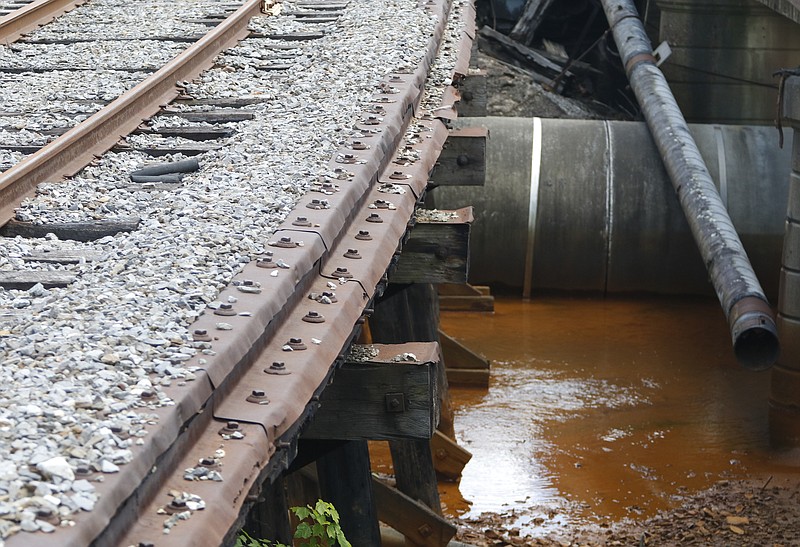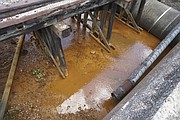It's amazing what's been done at this site in just 15 years.
DUCKTOWN, Tenn. - Standing in the Copper Basin today feels like standing in many rural Tennessee settings: rolling hills dotted with trees and grassy meadows, ponds alive with largemouth bass.
Step back to view it from a hilltop observation deck in the parking lot of the Ducktown Basin Museum and there are a few, subtle indicators this expansive stretch of land in the southeastern corner of the state is just a little bit different than the lush landscapes elsewhere in the region.
That it no longer shows the prolific scars of its past, however, is a testament to decades of restoration efforts and a partnership of public and private agencies that recently reached a milestone agreement in the denouement of one of the nation's most remarkable acts of reclamation.
If you go
What: Premiere of “It’s Home: Memories of the Ducktown Basin,” a 58-minute documentary by Old Town Productions exploring what life was like in the barren Copper Basin.When: Sunday, May 15 at 3 p.m.Where: Copper Basin High SchoolAdmission: Free. A DVD copy is available for purchase
The Department of Justice and the Environmental Protection Agency announced a $50 million settlement last month with OXY USA in the form of two consent decrees that amount to a formal shaking of hands on a water clean-up effort more than 25 years in the making on this land sullied by the lasting effects of 19th century smelting techniques and subsequent mineral extraction.
"It's kind of just buttoning up and formalizing the things that we've already done," said Rick Passmore, the Copper Basin site manager for Glenn Springs Holdings, the company leading the remediation efforts since 2001.
Visitors once traveled from all over the region to see the 50 square miles of red hills, devoid of grass and trees, that locals became accustomed to during the 20th century as mining slowed and eventually ceased in the late 1980s.
As the century wore on, efforts to restore life to the land and water quality picked up, leading to a dedicated restoration effort that began in 1990 with the parties involved in April's symbolic agreement.
Astronauts could once pick out Copper Basin from space for its misfitting appearance among a sea of green. Now there is concern that those growing up in the modern-day basin will not truly appreciate the unique story of the land.
This fear was one of the motives for Cleveland, Tenn.-based Old Town Productions to create a 58-minute documentary about life in the Copper Basin during its red years. The film premieres Sunday afternoon at Copper Basin High School.
"That's a big reason we wanted to do it, is because children have grown up there and they don't even realize the significance of the land," said Debbie Moore, co-owner of Old Town Productions with her husband, Ron. "You don't listen when your grandpa tells you about it. But if they take you to see a movie about it, maybe you'll understand. We want the community to remember this."
So do those who have restored it.
***
OXY USA, a subsidiary of Occidental Petroleum Co., is, in human terms, a step-parent of the Copper Basin.
Cities Service Co. owned 14,000 acres at the site from 1963 to 1982, using the land for the production of sulfuric acid, mineral proessing, smelting, and copper and iron mining.
Occidental acquired Cities Service in 1982. Cities Services sold its Copper Basin assets to the Tennessee Chemical Co. the same year, but Tennessee Chemical soon went bankrupt, leaving OXY USA liable for its assets.
In short, Occidental, an oil company with operations around the world, became legally responsible for cleaning up the waste left behind and the creeks destroyed from the 100-plus years of mineral extraction in the Copper Basin, even though the company never mined at the site.
Occidental and its environmental clean-up-oriented subsidiary, Glenn Springs Holdings, entered into a formal agreement with the EPA and the Tennessee Department of Environment and Conservation in 2001 to clean up the Copper Basin and restore the water quality of its creeks that feed the Ocoee River.
Two wastewater treatment plants were activated, billions of gallons of water have been treated, and dozens of meetings have been held in Glenn Springs Holdings' Ducktown office, which once served as a general store for the mining town, then a bank. Now, pictures of the old Copper Basin line the walls, a sign of reverence for the past and reminders of how much has been accomplished.
"It's amazing what's been done at this site in just 15 years," EPA site manager Loften Carr said.
There could have been drawn-out litigation over who was liable for the site. Officials say this could have been like old mines out west, where nobody takes responsibility and contamination festers.
Instead, the Copper Basin is a success story.
"It started in 2001, where every two months we were getting together with people from every technical level to plan out what was next," Passmore said. "It is really unique, and 15 years sounds like a while, but with the scale of the site, it's remarkable that things have happened and that you've seen the changes in water quality.
"I don't think I've ever seen a site where EPA, the state and other parties have worked closer together."
Passmore has traveled to the Copper Basin regularly for years to oversee the restoration and meet with EPA and TDEC personnel in this old building.
"There's a tremendous amount of pride in everything that's been accomplished here," he said while clutching a booklet with before-and-after photos depicting the progress that has been made.
The logo on the booklet's cover reads, "Preserving History, Ensuring the Future: Copper Basin Project."
***
The water quality of the Ocoee River has been a focus of the project. It's a lifeblood for Polk County, with its seasonal rafting industry supporting businesses and a sect of the county's tourism industry.
The Davis Mill Creek and North Potato Creek both discharged contaminant-filled water into the Ocoee River for decades until the remediation work of the 2000s led to the establishment of water treatment plants in 2002 and 2005.
Now, all water flow is strategic. Even the undulation in gravel pathways through the creek watersheds is designed to funnel runoff. The remedial work in those creeks has reduced the loading of metals into the Ocoee River by about 98 percent, according to Glenn Springs.
The North Potato Creek, for the first time since mining began, is home to fish life. One particular spot along the creek, once a hub for the primitive 19th century smelting, was remediated in 2008 and 2009 and now flows with water clean enough to support fish life and diverse biology.
"To me, this is always a spot I enjoy," Passmore said. "I come back, and it's hard to believe this is the same spot."
In 2014, the North Potato Creek was deemed fit to flow freely back into the Ocoee River downstream from that spot.
That was the proudest moment of the remediation process for Passmore.
"Getting that stream back to the Ocoee River without any treatment," he said, "a lot of people didn't think they would see that in their lifetime."
The color of Davis Mill Creek still bears an orange tint. That water is treated at the Cantrell Flats Water Treatment Plant before discharge into the river, and one of the two consent decrees focuses on ensuring the continued treatment of that water.
Much of the Davis Mill Creek watershed is owned by Copperhill Industries, a company that recycles iron calcine and copper slag by the ton for resale.
"Over the course of almost 150 years of mining and sulfuric acid production and mineral processing, you produce a lot of waste," Carr said. "There are literally tens of millions of tons of mining waste and byproducts disposed of or stockpiled on site, a lot of them in the Davis Mill Creek watershed."
Both the EPA and Glenn Springs describe Copperhill Industries as an ally.
"Recycling it is a good thing because we're re-using it and cleaning up the environment at the same time," Carr said.
***
The long-term plan is for the remediated land to be turned over to the Ducktown Basin Museum, which is operated on state-owned land. The vision for the Copper Basin includes recreational opportunities such as hiking and mountain biking trails.
They would fit well in an economy that is now reliant on tourism. The surrounding area is already known for its outdoor offerings, and the Copper Basin could be an extension of them, unmatched in historical significance.
Ken Rush, director of the museum, arrived in 1989, near the time mining operations ceased and when planes were flying over spraying seedlings by the millions to initiate the process of bringing sustainable green life back to the area.
He's not a local, but he's seen the area evolve into something few could imagine in the aftermath of its mining identity.
"Everything has an impact," he said. "There is nothing that has no impact. As a society, we have to decide if the impact is worth the benefit. At that time, the metal was considered more important than 50 square miles of trees in a remote corner of Tennessee that most people wouldn't see. I'm not saying that was the correct choice, but that's the choice that was made.
"We make choices today that we think are great, that 50 years or 100 years from now they'll say, 'What were they thinking?' And the reality is that a lot of times we just do the best we can."
Contact staff writer David Cobb at dcobb@timesfreepress.com or 423-757-6249.

